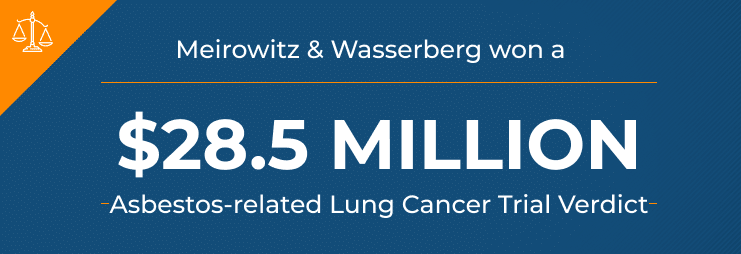Asbestos-Related Lung Cancer Lawsuit
Exposure to asbestos can cause several diseases, including lung cancer and pleural mesothelioma. Although these two cancers occur in a similar area of the body, they’re significantly different and respond differently to treatments. Asbestos exposure increases the risk of lung cancer ten-fold, which is further magnified in people who smoke.


Written by: Daniel Wasserberg
Daniel Wasserberg became an Asbestos & NYC personal injury lawyer because he was motivated to assist victims of injustice by fighting corporate entities that value profit over the public’s health and welfare. Mr. Wasserberg has been appointed one of “The Top 10 Asbestos Lawyers” by The National Trial Lawyers.
Asbestos exposure is known to cause various types of cancer. Mesothelioma is strongly associated with asbestos exposure, with 80 percent of pleural mesothelioma patients having a known history of exposure to this dangerous mineral. Asbestos exposure is also known to cause lung cancer.
Although lung cancer and pleural mesothelioma affect the lung, they arise from different tissues. This makes them behave differently; therefore, different treatments are required for each. At Meirowitz & Wasserberg, our NYC asbestos lawyers have extensive experience handling asbestos injury claims and will work with you to get the compensation you deserve.
Quick Links
How is Lung Cancer Different from Mesothelioma?
Both pleural mesothelioma and lung cancer affect the lung, so the symptoms are often similar. However, lung cancer occurs in the lung tissue, while mesothelioma affects the mesothelium, a membrane found around certain organs. The pleura is the mesothelium around the lungs, where pleural mesothelioma develops.
Lung cancer is the second most common type of cancer in the United States. The National Cancer Institute (NCI) estimates more than 236,700 new cases in 2022.
By contrast, mesothelioma is rare. Fewer than 3,000 mesothelioma cases are diagnosed each year in the United States. About 70 percent of these cases are pleural mesothelioma.
Asbestos Exposure and the Risk of Lung Cancer
Asbestos exposure is the major known risk factor for mesothelioma. While there are different risk factors for the development of lung cancer, it’s been established that asbestos exposure significantly increases the risk. Research in the International Journal of Environmental Research and Public Health has shown that nonsmokers exposed to asbestos had five times the risk of lung cancer than nonsmokers who weren’t exposed.
A study published in the British Journal of Cancer found that asbestos-related lung cancer causes twice as many deaths yearly as mesothelioma.
The Interaction Between Smoking and Asbestos Exposure
Of course, exposure to asbestos is not the only risk factor for lung cancer. According to the Centers for Disease Control and Prevention (CDC), a person who smokes is 15 to 30 times more likely to develop lung cancer than a nonsmoker.
The effects of asbestos exposure are enhanced in people who smoke. Smokers also exposed to asbestos have at least 50 times the lung cancer risk of people with neither of these risk factors. This is why it’s important for anyone who has ever been exposed to asbestos to quit smoking as soon as possible. The two risk factors interact to create a very high risk of lung cancer.

Symptoms of Asbestos-Related Lung Cancer
Lung cancer and pleural mesothelioma share some of the same symptoms regardless of what risk factors caused the cancer. The CDC reports that lung cancer symptoms may include:
- Shortness of breath
- Painful cough
- Coughing up blood
- Chest pain
- Wheezing
- Fatigue
- Unexplained weight loss
Similar symptoms can be caused by other common respiratory diseases, such as pneumonia or chronic obstructive pulmonary disease (COPD, also known as emphysema), and other types of cancer.
Diagnosis of Asbestos-Related Lung Cancer
In order to determine the cause of a patient’s symptoms, a variety of tests may be necessary.
- A chest X-ray is often the first step. This is used to rule out other diseases, like pneumonia. Sometimes, a tumor is visible on the chest X-ray, although this is not always the case.
- A CT scan is a more detailed type of imaging study. This may be performed after the chest X-ray, although it’s sometimes the first step in the diagnosis. Doctors can more precisely locate the tumor using a CT scan and determine how far it has spread within the area.
- A biopsy involves taking out a small piece of tissue from the area of the tumor. This is sent to a laboratory to be examined under a microscope. Based on the characteristics of the cells, a specialist can determine whether they’re cancerous and, if so, what type of cancer they are. A biopsy is always necessary to diagnose any type of cancer.
In addition to making the general diagnosis of lung cancer, a few specific features of the cancer need to be determined before a treatment plan can be created. These include the cell type and the stage of cancer.
- The cancer cell type is determined based on certain characteristics of the cancer cells. For lung cancer, the two main types are small cell lung cancer (SCLC) and non-small cell lung cancer (NSCLC).
- The stage of cancer refers to how widely it has spread within the body. It’s usually reported as a number from 1 to 4, with higher numbers indicating a more extensive spread. For SCLC, however, a simpler system is generally used, with the spread of the cancer being classified as either “limited” or “extensive.” Cancers diagnosed at an earlier stage are usually easier to treat.
Additional testing, such as an MRI or PET scan, may be performed to determine the stage of the cancer. Once the stage and cell type are known, an appropriate treatment plan can be developed.
How do doctors determine whether lung cancer is asbestos-related?
It’s difficult, if not impossible, to know precisely what caused an individual case of cancer. Although we may know of factors that increase the risk of certain cancers, we still can’t be sure exactly what caused cancer to develop in a particular person at a particular time.
However, the determination that a particular case of cancer is “asbestos-related” can have significant implications for a patient’s legal and financial options, and it’s important to have a clear and consistent method of making this determination.
There’s a set of generally accepted criteria for determining that a patient’s lung cancer is asbestos-related. The factors that are considered include:
- Whether the patient has asbestosis (another asbestos-related disease in which scarring occurs throughout the lung). This is an indication of significant asbestos exposure.
- Changes in the pleura indicate exposure to asbestos, such as pleural plaques (areas of thickening).
- The presence of asbestos fibers in the patient’s lung tissue, or in fluids sampled from in or around the lung.
- Known history of asbestos exposure. This must have occurred at least ten years in the past to account for the latency period between asbestos exposure and the development of lung cancer.
Asbestosis and pleural plaques don’t directly lead to cancer; instead, they serve as indicators of asbestos exposure. However, if a patient does have asbestosis, it is a clear indication they were exposed to enough asbestos to cause lung cancer.
Asbestos fibers are not always found in the tissues of patients with asbestos-related cancer. The fibers are very tiny and can be hard to find. However, even if asbestos is not directly observed in the patient’s tissues, the presence of other indicators of asbestos exposure is enough to consider their lung cancer to be asbestos-related.

Treatment Options for Lung Cancer
The treatment options for lung cancer don’t change based on what caused the cancer. There is no known way to remove asbestos from the body once it has entered the tissues. The cancer treatment will be the same whether a patient’s lung cancer was caused by asbestos, smoking, or other factors.
There are several treatment options for lung cancer. Many patients receive a combination of treatment types.
Tumor-Removing Surgery
In patients with early-stage lung cancer, surgery may be used to attempt to remove the tumor. Depending on the location of the cancer and the patient’s medical condition, the American Lung Association describes the different procedures that can be used:
- Pneumonectomy, or removal of the whole lung affected by cancer
- Lobectomy, or removal of one lobe (section) of the affected lung
- Wedge resection, or removal of a wedge-shaped part of the lung surrounding the cancerous tissue
Chemotherapy
Chemotherapy uses medications to destroy cancer cells and is typically given to the whole body through an IV. Chemotherapy is often the mainstay of treatment for patients in more advanced stages. It can also be used along with surgery in the following ways:
- Adjuvant chemotherapy is given after surgery to decrease the chance of cancer returning.
- Neoadjuvant chemotherapy is given before surgery to shrink the tumor and make it easier to remove.
Radiation Therapy
Radiation therapy involves using beams of energy to destroy cancer cells. Multiple beams of radiation are aimed at the tumor from outside the body. The beams cross at the tumor site, delivering a high dose of radiation to the cancer cells while minimizing the exposure of healthy tissues to radiation.
Radiation therapy can be used to target tumors that can’t be removed surgically. It can also be combined with surgery. Like chemotherapy, radiation can be given either before or after surgery.
Immunotherapy
Immunotherapy is a cancer treatment that stimulates the patient’s immune system to target cancer cells. According to the NCI, a few immunotherapy drugs are FDA-approved for treating certain patients with non-small cell lung cancer. Immunotherapy can be used instead of chemotherapy, or both can be used together.
Palliative Care
Eliminating the cancer may not be a realistic goal for patients diagnosed in a late stage (meaning that it has already spread widely through the body). These patients often receive palliative care, where the goal is to maintain the patient’s quality of life as much as possible.
There are some patients for whom more aggressive, life-extending therapy is an option, but they prefer palliative care instead. Some people would instead focus on enjoying their remaining time with their families than enduring the side effects of aggressive cancer treatments. It’s important to talk with your treatment team about your goals and preferences since you decide which treatments you’re willing to accept.
There are several palliative care options that may be helpful for lung cancer patients. These include some of the same treatments used for life-extending therapy, but the focus of the treatment is different.
- Medications may help manage symptoms such as nausea, pain, and shortness of breath.
- Procedures may also help with symptom management. One example is thoracocentesis, in which doctors drain fluid around the lung to help improve symptoms like shortness of breath.
- Surgery can be used to remove particular tumors or parts of tumors that are causing significant symptoms. For example, if a tumor is blocking a primary airway and causing shortness of breath, surgeons could remove enough of the cancer to open the airway.
- Chemotherapy or radiation therapy can be used to shrink tumors that are causing significant symptoms. The side effects of the therapy must be balanced against the benefit of reducing the symptoms caused by the tumor.
Patients who receive life-extending therapy may also receive palliative treatments, such as medications.
Legal Considerations for Patients with Asbestos-Related Lung Cancer

People with asbestos-related lung cancer were often exposed to this dangerous mineral at work. Even after the dangers of asbestos were known, many companies did not put proper safety precautions in place. They chose increased profits over the safety of their workers, putting both workers and workers’ families at risk.
Companies can be held legally liable for the harm they cause through their negligence. If you or a loved one developed asbestos-related lung cancer, you may be entitled to receive financial compensation through a lawsuit or settlement fund. This can make a huge difference in relieving the financial burden that lung cancer often causes.
If you or a family member has asbestos-related lung cancer, we invite you to contact our asbestos lawyers for a case review where we can learn more about your situation and determine your eligibility to file. At Meirowitz & Wasserberg, we believe injured workers and their families deserve justice, and we are ready to fight on your behalf.
AVAILABLE 24/7
Get Your Free Case ReviewNotable Results
$32,000,000+
Asbestos Exposure Verdict
$5,100,000+
Mesothelioma Settlement
$4,000,000+
Mesothelioma Settlement
Mesothelioma Related Cases
related Mesothelioma cases by Meirowitz & Wasserberg
Mesothelioma cases handled by Attorneys at Meirowitz & Wasserberg
Asbestos related cases by Meirowitz & Wasserberg








